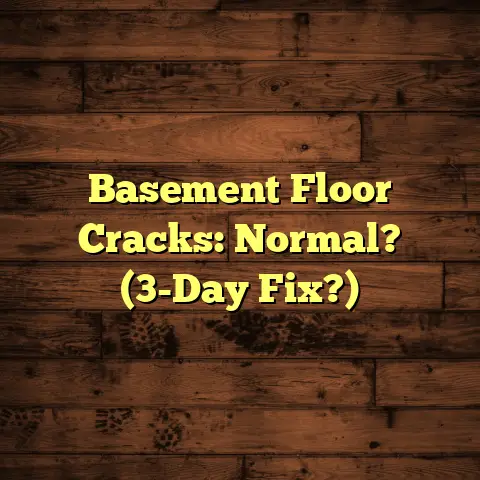Stop Bed Moving On Laminate (6 Fixes!)
There’s a common misconception out there that laminate flooring is just inherently unstable, that it’s not suitable for heavy furniture.
And I get it, nobody wants their bed doing the cha-cha across the room every time they roll over.
But I’m here to tell you that’s
simply not true.
Laminate can be just
as stable as hardwood or tile, even
under the weight of a big, comfy bed.
The key?
Understanding the problem
and using the right solutions.
I’ve been installing and fixing floors
for over 15 years, and I’ve seen it all.
So, let’s dive into how to keep your bed exactly where you want it.
Section 1: Understanding the Problem
Okay, so why do beds move on laminate?
It’s not just some random act of
furniture rebellion.
There’s actually
some physics involved.
1. What Causes Beds to Move on Laminate?
Think about it: you’ve got a heavy
object (your bed) sitting on a smooth
surface (laminate).
The weight is
concentrated on a few small points.
Those points are the bed legs.
Now,
laminate, while durable, doesn’t have
the same grip as, say, a textured
tile or a carpeted floor.
It’s a bit like trying to ice skate
on a freshly Zambonied rink – slippery!
A big part of it comes down to:
Weight Distribution: A bed with uneven weight distribution is more likely to move.
If one side is heavier than the other, it will naturally want to shift in that direction.Floor Texture: Laminate is smooth, that’s why we love it!
But that smoothness also means less friction.
The smoother the floor, the easier it is for the bed to slide.Furniture Leg Design: Those sleek, modern metal legs might look amazing, but they’re not doing you any favors when it comes to stability.
Wide, flat legs or legs with rubberized bottoms are much better at staying put.
And think about when bed movement is
most problematic: when you’re sleeping!
Tossing and turning, getting in and out,
all those movements add up.
2. The Impact of Bed Movement
So, what’s the big deal if your bed
moves a little?
Well, a little movement
over time can cause some real problems.
First, there’s the potential damage
to both the bed frame and the laminate.
That constant shifting can scratch the
laminate surface and weaken joints.
I’ve seen bed frames with legs that have completely snapped off due to repeated stress from sliding.
But it’s not just about the physical
damage.
A wobbly bed can disrupt your
sleep.
And let’s be honest, nobody
needs more sleep disruption.
According to the CDC, adults need
at least 7 hours of sleep per night.
(Source: https://www.cdc.gov/sleep/about_sleep/how_much_sleep.html)
A bed that shifts and creaks every time you move can make it tough to get those precious hours of rest.
Plus, it’s just plain annoying.
Having to constantly readjust your
bed is a hassle.
So, let’s get into
some fixes, shall we?
Section 2: Fix #1 – Use Furniture Coasters
This is one of the simplest and most effective solutions I recommend to my clients all the time: furniture coasters.
They’re inexpensive, easy to install, and can make a huge difference in preventing bed movement.
Think of them as little grippy shoes for your bed legs.
Coasters work by increasing the surface
area of contact between the bed leg
and the floor.
This creates more
friction, making it harder for the bed
to slide.
There are a few different types of coasters you can choose from:
Rubber Coasters: These are great for providing a strong grip.
Rubber is naturally tacky, so it clings to both the bed leg and the laminate floor.Felt Coasters: Felt is a softer option that’s good for protecting your laminate from scratches.
However, it doesn’t provide as much grip as rubber.Cork Coasters: Cork is a good compromise between grip and protection.
It’s also a sustainable material, which is a plus.
Here’s how to choose and install coasters:
Measure Your Bed Legs: Make sure you get coasters that are the right size for your bed legs.
Too small, and they won’t be effective.
Too big, and they’ll look clunky.Clean the Area: Before you install the coasters, clean the area around each bed leg to remove any dirt or debris.
This will help the coasters adhere better.Place the Coasters: Simply lift each bed leg (or have someone help you) and slide a coaster underneath.
Make sure the coaster is centered under the leg.
That’s it!
You’ve just added a layer
of protection and stability to your bed.
I usually recommend rubber coasters
for maximum grip, but felt or cork
can be good options if you’re
concerned about scratches.
Section 3: Fix #2 – Anti-Slip Mats
Alright, let’s move on to another excellent solution: anti-slip mats.
These are similar to coasters in that they provide a grippy surface, but they cover a larger area.
Think of them as a non-slip rug
that goes underneath your entire bed.
Anti-slip mats are typically made
from materials like:
PVC Foam: This is a common material for anti-slip mats.
It’s durable, water-resistant, and provides good grip.Rubber: Rubber mats are another great option.
They’re super grippy and can handle a lot of weight.-
Felt with Rubber Backing: These mats combine the scratch protection of felt with the grip of rubber.
Installation is pretty straightforward:
Measure Your Bed: You’ll want to get a mat that’s slightly larger than the footprint of your bed.
This will ensure that all the legs are resting on the mat.-
Clean the Floor: As with the coasters, make sure the floor is clean before you lay down the mat.
-
Place the Mat: Carefully position the mat on the floor where your bed will go.
-
Position Your Bed: Gently lift and place your bed on top of the mat, making sure all the legs are fully supported.
I’ve found that PVC foam mats are a good
all-around choice.
They’re affordable,
easy to cut to size, and provide decent
grip.
Rubber mats are a bit more expensive,
but they’re worth the investment if you
have a particularly heavy bed.
Where can you find these mats?
Home improvement stores like Home Depot
or Lowe’s usually carry a selection of
anti-slip mats.
You can also find them
online at Amazon or specialty flooring
stores.
Section 4: Fix #3 – Bed Frame Modifications
Sometimes, the problem isn’t just the
floor; it’s the bed frame itself.
If your bed frame is flimsy or poorly
designed, it’s going to be more prone
to movement, no matter what kind of
floor you have.
In these cases, some modifications might be in order.
Adding a Plywood Base: One common issue I see is bed frames with flimsy slats that don’t provide enough support.
A simple fix is to add a plywood base on top of the slats.This will create a solid, stable surface for your mattress to rest on.
Just make sure the plywood is thick enough to support the weight.
I usually recommend at least 3/4 inch.Reinforcing the Frame: Another option is to reinforce the bed frame with additional support beams.
You can add these beams to the inside of the frame, using screws and wood glue to secure them in place.This will make the frame more rigid and less likely to flex or wobble.
I’ve done this for several clients with older bed frames, and it makes a huge difference.
Here’s how to do it safely:
-
Gather Your Materials: You’ll need plywood (if adding a base), wood for support beams, screws, wood glue, a drill, a saw, and a measuring tape.
-
Measure and Cut: Measure the inside dimensions of your bed frame and cut the plywood or support beams to the appropriate size.
Assemble and Secure: If adding a plywood base, simply lay the plywood on top of the slats.
If reinforcing the frame, attach the support beams to the inside of the frame using screws and wood glue.Test for Stability: Once you’ve made the modifications, test the bed frame for stability.
Make sure it feels solid and doesn’t wobble or creak.
Safety first!
Always wear safety glasses
when working with power tools, and be
careful when lifting heavy objects.
If you’re not comfortable doing these
modifications yourself, hire a professional
carpenter to do it for you.
Section 5: Fix #4 – Adjusting Weight Distribution
This might sound a little out there, but hear me out: how you arrange your bedding and accessories can actually affect how much your bed moves.
Think about it: if you pile all your
heavy blankets and pillows on one side
of the bed, that side is going to be
heavier.
This can create an imbalance
that makes the bed more likely to shift.
Evenly Distribute Bedding: Try to distribute your bedding evenly across the bed.
Don’t pile all the blankets on one side.-
Balance Accessories: If you have bedside tables or lamps, make sure they’re evenly balanced on both sides of the bed.
Consider Mattress Placement: If your mattress is particularly heavy, try to center it on the bed frame.
This will help distribute the weight more evenly.
Here’s a quick example: I had a client
who was convinced her bed was cursed.
It kept sliding across the room, no
matter what she did.
Turns out, she had a giant stack of books on one side of her bed, and nothing on the other.
Once she moved the books to a bookshelf,
the bed stopped moving.
Simple as that!
It’s all about finding that sweet spot
where the weight is evenly distributed.
You might need to experiment a little
to find the perfect balance, but it’s
worth it.
Section 6: Fix #5 – Use of Velcro Strips
Okay, this is where we get a little more creative. Velcro strips!
Yes, the same stuff you use to fasten your shoes can also be used to keep your bed from sliding around.
The idea is simple: you attach one side of the Velcro strip to the bottom of the bed frame and the other side to the laminate floor.
The Velcro creates a strong bond that prevents the bed from moving.
Here’s how to do it:
-
Clean the Surfaces: Make sure both the bottom of the bed frame and the laminate floor are clean and dry.
Cut the Velcro Strips: Cut the Velcro strips into small pieces (about 2-3 inches long).
You’ll need enough strips to place under each bed leg and along the sides of the frame.Apply the Velcro: Peel off the backing from one side of the Velcro strip and stick it to the bottom of the bed frame.
Then, peel off the backing from the other side and carefully position the bed over the desired spot on the floor.
Press down firmly to adhere the Velcro to the floor.Test the Bond: Give the Velcro a few minutes to set, then test the bond by gently trying to move the bed.
If it feels secure, you’re good to go.
Now, there are a few things to keep
in mind with this method.
First, it
can be a little tricky to remove the
Velcro without damaging the laminate.
I recommend using a hair dryer to
warm up the adhesive before pulling
it off.
This will make it easier to
remove and less likely to leave
residue.
Also, this method works best with
lighter beds.
If you have a super
heavy bed, the Velcro might not be
strong enough to hold it in place.
But for many people, Velcro strips are a simple and effective solution.
Section 7: Fix #6 – Floor Anchoring Solutions
Alright, let’s talk about the big guns.
If you’ve tried all the other fixes
and your bed is still moving, it
might be time to consider floor
anchoring solutions.
These are more permanent solutions that involve physically attaching the bed frame to the floor.
There are a few different types of floor anchors you can use:
Furniture Straps: These are straps that attach to the bed frame and then to the floor using screws or anchors.
They’re relatively easy to install and provide a strong hold.Corner Braces: These are metal brackets that attach to the corners of the bed frame and then to the floor.
They’re a bit more involved to install, but they provide excellent stability.Bed Rail Fasteners: These are special fasteners that are designed to attach bed rails directly to the floor.
They’re typically used for platform beds or beds with built-in storage.
Here’s a general overview of the installation process:
-
Choose Your Anchors: Select the type of floor anchors that are best suited for your bed frame and your laminate floor.
-
Mark the Locations: Position your bed in the desired location and mark the spots where you’ll be installing the anchors.
Drill Pilot Holes: Drill pilot holes into the laminate floor at the marked locations.
Be careful not to drill too deep!-
Attach the Anchors: Attach the anchors to the bed frame and then to the floor using screws or bolts.
Test for Stability: Once you’ve installed the anchors, test the bed for stability.
Make sure it feels solid and doesn’t move.
Now, I want to be clear: installing
floor anchors is a more involved
process than the other fixes we’ve
discussed.
It requires some basic
carpentry skills and the use of power
tools.
If you’re not comfortable doing it yourself, hire a professional to do it for you.
But the long-term benefits can be
significant.
Floor anchors provide
the ultimate in stability and peace
of mind.
You’ll never have to worry
about your bed sliding around again.
Conclusion
So, there you have it: six effective fixes to stop your bed from moving on laminate flooring.
From simple solutions like furniture coasters to more involved options like floor anchors, there’s a fix out there for everyone.
The key takeaway here is that laminate flooring can be a viable choice for bedrooms without the worry of furniture instability.
You just need to be proactive and take the necessary steps to keep your bed in place.
I encourage you to evaluate your specific situation and consider implementing one or more of the solutions we’ve discussed.
With a little bit of effort, you can create a bedroom that’s both stylish and functional.
And who knows, you might even get a
better night’s sleep!
Good luck, and happy flooring!





